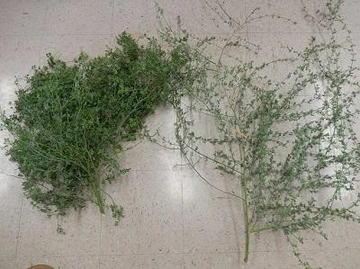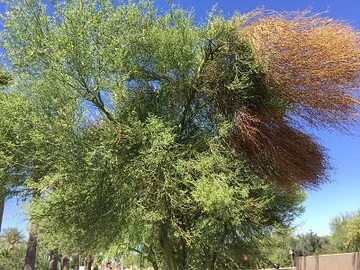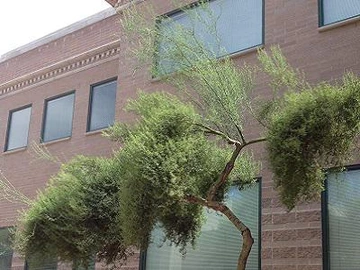A Growing Problem
Witches broom disease of blue palo verde (Parkinsonia florida) has become very common in southern Arizona landscapes. Blue palo verde is native to the Sonoran Desert and is the state tree of Arizona. It is very popular in urban landscapes because of the striking, green-colored trunk and branches, spectacular yellow flowers in spring, fast growth rate, and excellent performance in the arid climate. Witches broom disease symptoms are characterized by clusters of dense, short branches with leaves and that lack thorns and can occur on one or a few branches, or throughout much of the tree canopy. Some virus-infected trees may not develop broom symptoms after being transplanted into the landscape, while in others the majority of branches have broom symptoms, giving the canopy the appearance of a dense shrub.
Concerns associated with witches broom disease in landscape trees include broom dieback, breaking of large brooms during storms, and structural issues caused by the removal of broom branches, and damage caused by sunburning of branches in the canopy when they become exposed to direct sunlight. Witches broom disease of palo verde is primarily found in blue palo verde, however, recently witches broom disease symptoms have been observed in other palo verde species including Foothills palo verde (Parkinsonia microphylla), and Mexican palo verde (Parkinsonia aculeata).
Palo Verde Broom Virus (PVBV)
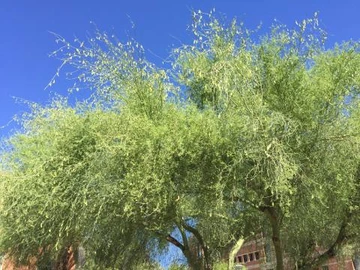
Several brooms are strating to grow in the canopy of this blue paloverde.
University of Arizona
Witches broom symptoms on palo verde trees were first described over 50 years ago, but the cause of the disease was unknown until recently. Our research has shown that a previously unknown multi-segmented, single-stranded RNA plant virus, classified in the genus Emaravirus, infects palo verde trees. This plant virus associated with broom-affected palo verde trees is a new discovery and has been confirmed in blue palo verde, Mexican palo verde, and Foothills palo verde. The presence of the palo verde broom virus also has been confirmed by molecular detection methods in Sonoran palo verde or Palo Brea (P. praecox), the Desert Museum hybrid palo verde (Parkinsonia x ‘Desert Museum’), and in other palo verde hybrids despite the absence of characteristic disease symptoms.
About 60 percent of the viral genome sequence is most similar to another plant virus named High Plains wheat mosaic virus, which is also transmitted by a species of eriophyid mite.
Other emaravirus species are known to infect European mountain ash (Sorbus aucuparia), fig (Ficus carica), pigeonpea (Cajanus cajan), raspberry (Rubus spp.), and rose (Rosa multiflora). The symptoms characteristic of emaravirus infection in these species are blotching, chlorotic ringspots, mottling of leaves, smaller than normal or stunted leaves, and densely clustered, multiple shoots.
Detection
Based on the results of a molecular detection test, the PVBV is present in shoots, leaves, flowers, seeds, and adventitious shoots from palo verde trees that show broom symptoms. The PVBV can also be detected in the leaves or shoots of trees that exhibit no characteristic disease symptoms. This may be because infection has occurred recently, and/or possibly because certain palo verde species may be tolerant to PVBV infection. However, the PVBV has been shown to be undetectable in many trees that have no broom symptoms, indicating they are likely not infected, and are virus-free.
Disease Transmission
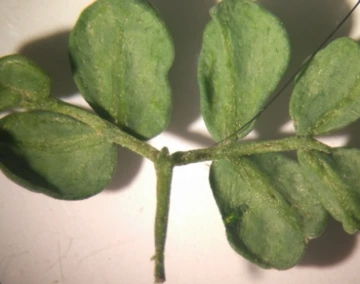
Hundreds of eriophyid mites have colonized these leaves of blue palo verde. An eyelash in the picture serves as reference.
S. Avelar, Brown Lab, U of A Plant Sciences
All known emaraviruses have been found to be transmitted by an eriophyid mite, making it the only known ‘biological’ vector. These arthropods are often host specific, meaning they populate only one genus or possibly a single species of plant. The presence of the eriophyid mite Aculus cercidi (Keifer, 1965) has been associated with broom symptoms in palo verde for some time, and it was suspected to cause feeding damage that resulted in the development of broom symptoms. However, until now, no causal relationship had been established between the eriophyid mite and the broom symptoms in palo verde trees.
Based on several years of collecting insects and arthropods from broom infested and healthy, non-symptomatic trees, we found consistently high populations of A. cercidi infesting trees with broom symptoms, while mites were in low abundance or rarely found in apparently healthy, non-symptomatic trees. Confirming the presence of the emaravirus in mites collected from broom infected trees provided further evidence of mites as the vector in transmitting the witches broom disease. This strong association between the presence of the emaravirus in broom of blue palo verde trees that were heavily infested with the suspected eriophyid vector, the absence of both the virus and vector on non- symptomatic trees, and presence of the virus in eriophyid mites, strongly support a causal relationship between emaravirus and the witches broom disease of blue palo verde.
Eriophyid mites are sometimes confused with spider mites. Eriophyid mites are wedge-shaped, very small, and require an approximately 20x magnification hand lens to see on a plant and at least 80x magnification to observe the different life stages more closely under a microscope. Identification of eriophyid mite species requires an image taken with an electron microscope and the assistance of a mite expert; mite samples we collected have been identified as A. cercidi using these tools.
Management
There is no cure for witches broom in palo verde. Recommendations for limiting the spread of the virus causing witches broom in Parkinsonia species include controlling the eriophyid vector in nursery production and pruning out brooms in landscape trees.
Managing witches broom in nursery production:
- Ensure seeds for seedling production are from trees that show no broom symptoms because seeds may be infected by the palo verde broom emaravirus.
- Protect young seedlings from mite infestations by placing them in screenhouses and treating them with miticides.
- Discarding seedlings showing broom symptoms to reduce virus incidence in the propagation area. Small seedlings that display broom symptoms sometimes grow out of it based on our observation that broom symptoms disappeared as seedlings increased in size.
Managing witches broom in landscape trees:
- Prune trees without broom symptoms first, clean pruners between each tree. Based on similar plant/disease systems, it is likely that the emaravirus can be transmitted by contaminated pruners
- Cut out brooms, although they grow back in most cases. In our research we found almost year-round much higher numbers of eriophyid mites in broom tissue on trees in the landscape than on non-symptomatic trees. Removing the broom will remove large numbers of the eriophyid vector and potentially slow further infection of other trees.


